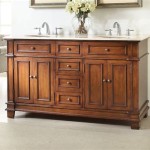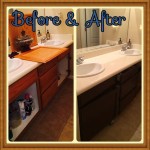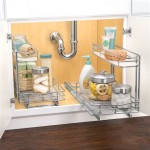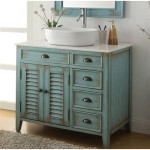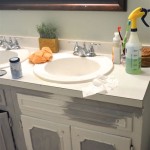Can You Paint a Bathroom Counter? A Comprehensive Guide
Painting a bathroom counter is a viable option for homeowners seeking to refresh the look of their bathroom without undertaking a full-scale renovation. Instead of replacing a dated or worn countertop, painting offers a potentially cost-effective and relatively simple solution. However, the success and longevity of a painted bathroom counter depend heavily on proper preparation, appropriate material selection, and meticulous application techniques. This article will explore the intricacies of painting a bathroom counter, outlining the essential steps, considerations, and limitations involved in this process.
The appeal of painting a bathroom counter lies primarily in its potential to dramatically alter the aesthetic of the space at a fraction of the cost of replacement. A fresh coat of paint can breathe new life into a tired bathroom, allowing homeowners to experiment with different colors and styles without committing to a permanent and expensive renovation. Furthermore, painting can cover minor imperfections, such as scratches or stains, offering a temporary fix and extending the lifespan of the existing countertop.
Despite its advantages, painting a bathroom counter is not a universally suitable solution. The bathroom environment presents several challenges that can impact the durability of a painted finish. High humidity, frequent water exposure, and the potential for harsh cleaning chemicals all contribute to the wear and tear of the painted surface. Consequently, careful planning and the selection of appropriate products are crucial to achieving a long-lasting and aesthetically pleasing result.
Key Considerations Before Painting
Before embarking on a bathroom counter painting project, several key factors must be carefully considered to determine if painting is the right solution. The existing countertop material, its condition, and the desired outcome all play a significant role in the success of the project.
The countertop material is a primary factor. Laminate, ceramic tile, and solid surface materials like Corian are generally suitable for painting, though each requires specific preparation techniques and primer selections. Natural stone countertops, such as granite or marble, are typically not recommended for painting. These materials are porous and prone to absorbing paint unevenly, and the paint can also damage the stone's finish and reduce its value.
The condition of the existing countertop is equally important. Minor imperfections, such as small scratches or stains, can be effectively concealed with paint. However, if the countertop has significant damage, such as deep cracks, chips, or water damage, painting may not be a viable solution. Addressing these underlying issues is crucial before proceeding with any painting project; otherwise, the paint will likely fail prematurely.
Finally, consider the desired outcome. Painting a bathroom counter is unlikely to replicate the look and feel of a new countertop. While a fresh coat of paint can improve the appearance of the existing surface, it will not fundamentally alter its texture or material properties. If the ultimate goal is to achieve a high-end, luxurious look, replacing the countertop may be a more suitable option.
Essential Steps for Painting a Bathroom Counter
If painting is deemed an appropriate solution, meticulous preparation and careful application are essential for achieving a durable and aesthetically pleasing finish. The following steps outline the critical stages involved in painting a bathroom counter.
Preparation: This is arguably the most crucial step in the entire process. Proper preparation ensures that the paint adheres correctly to the surface and provides a long-lasting finish. The first step is to thoroughly clean the countertop with a degreasing cleaner to remove any dirt, grime, or soap scum. Next, sand the surface lightly with fine-grit sandpaper (e.g., 220-grit) to create a slightly rough texture that will promote adhesion. After sanding, wipe the surface clean with a tack cloth to remove any sanding dust. Any repairs, such as filling chips or cracks, should be done at this stage.
Priming: Applying a high-quality primer is essential for ensuring that the paint adheres properly to the countertop surface. Select a primer specifically designed for the material of your countertop (e.g., a primer for laminate or a primer for tile). Apply the primer in thin, even coats using a brush or roller, allowing each coat to dry completely according to the manufacturer's instructions. Two coats of primer are often recommended for optimum adhesion and coverage.
Painting: Once the primer has dried completely, you can begin painting the countertop. Select a high-quality paint specifically formulated for use in bathrooms. Epoxy-based paints or paints designed for cabinets and furniture are generally good choices, as they are durable and resistant to moisture. Apply the paint in thin, even coats using a brush or roller. Avoid applying too much paint at once, as this can lead to drips and uneven coverage. Allow each coat to dry completely before applying the next. Two or three coats of paint are typically needed to achieve full coverage and a durable finish.
Sealing: After the paint has dried completely, apply a clear topcoat or sealant to protect the painted surface from water damage and wear and tear. Select a sealant specifically designed for use on painted surfaces in bathrooms. Polyurethane sealants are a popular choice, as they are durable and water-resistant. Apply the sealant in thin, even coats using a brush or roller, allowing each coat to dry completely according to the manufacturer's instructions. Two or three coats of sealant are typically recommended for optimum protection.
Choosing the Right Materials and Products
The success of a bathroom counter painting project hinges on selecting the right materials and products. Using high-quality products specifically formulated for use in bathrooms will significantly increase the durability and longevity of the painted finish.
Primer: Selecting the right primer is crucial for ensuring proper adhesion. For laminate countertops, use a bonding primer specifically designed for non-porous surfaces. For tile countertops, use a primer designed for tile or ceramic surfaces. Avoid using general-purpose primers, as they may not provide adequate adhesion, especially in the humid environment of a bathroom.
Paint: Choose a high-quality paint that is durable, water-resistant, and easy to clean. Epoxy-based paints are a popular choice for bathroom counters, as they offer excellent durability and resistance to water damage. Paints designed for cabinets and furniture are also a good option. Avoid using latex paints, as they are generally not durable enough for high-use surfaces in bathrooms. Consider the sheen level of the paint as well. Semi-gloss or gloss finishes are easier to clean and more resistant to moisture than matte finishes.
Sealant: Applying a clear topcoat or sealant is essential for protecting the painted surface from water damage and wear and tear. Choose a sealant specifically designed for use on painted surfaces in bathrooms. Polyurethane sealants are a popular choice, as they are durable and water-resistant. Ensure that the sealant is compatible with the type of paint you are using to avoid any compatibility issues.
Tools: In addition to the right paints and sealants, having the right tools is essential for achieving a professional-looking finish. Use high-quality brushes and rollers designed for smooth application. A paint sprayer can also be used for applying paint and sealant, but it requires more skill and experience. Other essential tools include sandpaper, tack cloth, painter's tape, drop cloths, and safety glasses.
By carefully considering these factors and following these steps, homeowners can successfully paint a bathroom counter and transform the look of their bathroom without breaking the bank. However, it is important to remember that painting is not a permanent solution and may require periodic touch-ups or reapplication over time.

Paint Bathroom Vanity Countertop Sink So Easy A Piece Of Rainbow

How To Easily Spray Paint Bathroom Countertops My Homier Home
:strip_icc()/101922779-2cbc45e123c34827afb4f601723b03ca.jpg?strip=all)
How To Paint Bathroom Countertops

How To Paint A Countertop Don T Make These Mistakes Blessed Beyond Crazy

Paint Bathroom Vanity Countertop Sink So Easy A Piece Of Rainbow

How To Paint Tile Countertops And Our Modern Bathroom Reveal Bright Green Door

How To Paint A Countertop Don T Make These Mistakes Blessed Beyond Crazy

Should You Be Painting Your Bathroom Countertops Caesarstone

Before And After Bathroom Vanity Transformation With Painted Tile Countertop The Minimal Ish Mama

Can You Paint A Countertop Re Sick Of Absolutely Recreated Designs
Related Posts
